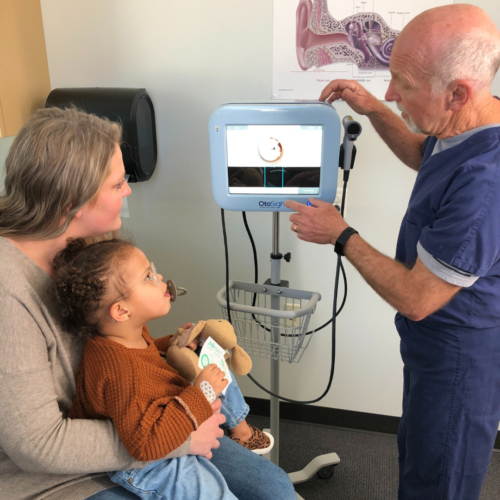Phone
866-411-EARS
Address
PhotoniCare Inc.
2800 Meridian Parkway, Suite 175
Durham, NC 27713

Despite its small size, the ear is a very complicated organ. The three main parts of the ear are known as the inner, middle, and outer ear. PhotoniCare focus their research and work on the middle ear. The middle ear is the area located directly behind the eardrum.
Most middle ear infections are caused by either bacteria or viruses. A common cold, the flu, or allergy symptoms that cause congestion and swelling of the nasal passages, throat, and eustachian tubes can sometimes lead to an infection. Anything that makes the nose stuffy has a tendency to cause swelling and blockage of the eustachian tubes. Swelling from colds or allergies can keep the eustachian tubes from opening and this leads to pressure changes and the accumulation of fluid in the middle ear. This pressure and fluid will cause pain and sometimes persistent fluid can lead to an infection.
When a healthcare provider checks you or your child for an ear infection, they will typically use an instrument called an otoscope. An otoscope is basically a pen light attached to a magnifying glass, and this simple device has been used in medicine for the past 150 years. The otoscope comes with several pointed tips called specula. A speculum is chosen based on the size of the patient’s ear opening. The healthcare provider will gently insert the speculum into the ear canal to look at the surface of the eardrum. The otoscope will allow the provider to look at the surface of the eardrum.


Note: These are ideal, textbook images of the surface of the eardrum that you or your family healthcare provider rarely see because there may be wax blocking his/her view, or the patient may be uncooperative, which prevents proper positioning of the otoscope. These real-life impediments are what makes diagnosing AOM so difficult.
When to Visit Your Healthcare Provider
Ear pain and concerns about hearing are one of the most common reasons parents take their children to the doctor. If you suspect that your child has an ear infection, then the #EnginEarGuys recommend you contact your healthcare provider. A provider will examine your child’s ear for an infection or if there is another issue causing your child’s symptoms and pain. If the provider does suspect an ear infection, antibiotics may or may not be recommended.
Generally speaking, an ear infection has the potential to resolve itself without antibiotic treatment. In the case of a severe middle ear infection with infected fluid in the middle ear, the American Academy of Pediatrics recommends the physician prescribe antibiotics. However, the guidelines recommend the “watchful waiting” approach for non-severe middle ear infections in children over the age of two. The overall goal is to reduce over-prescription of antibiotics.

The COVID-19 pandemic has created numerous challenges for parents. Navigating… Read More

PhotoniCare sits down with Dr. Michael Novak, an Ear, Nose… Read More

This week on the #EnginEarGuys blog we talk about otolaryngology… Read More